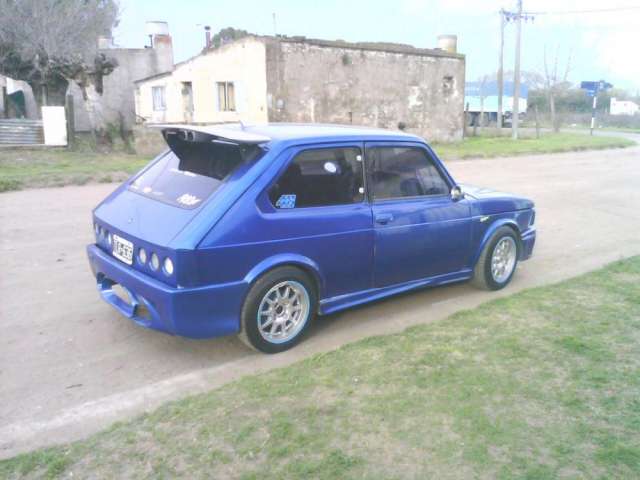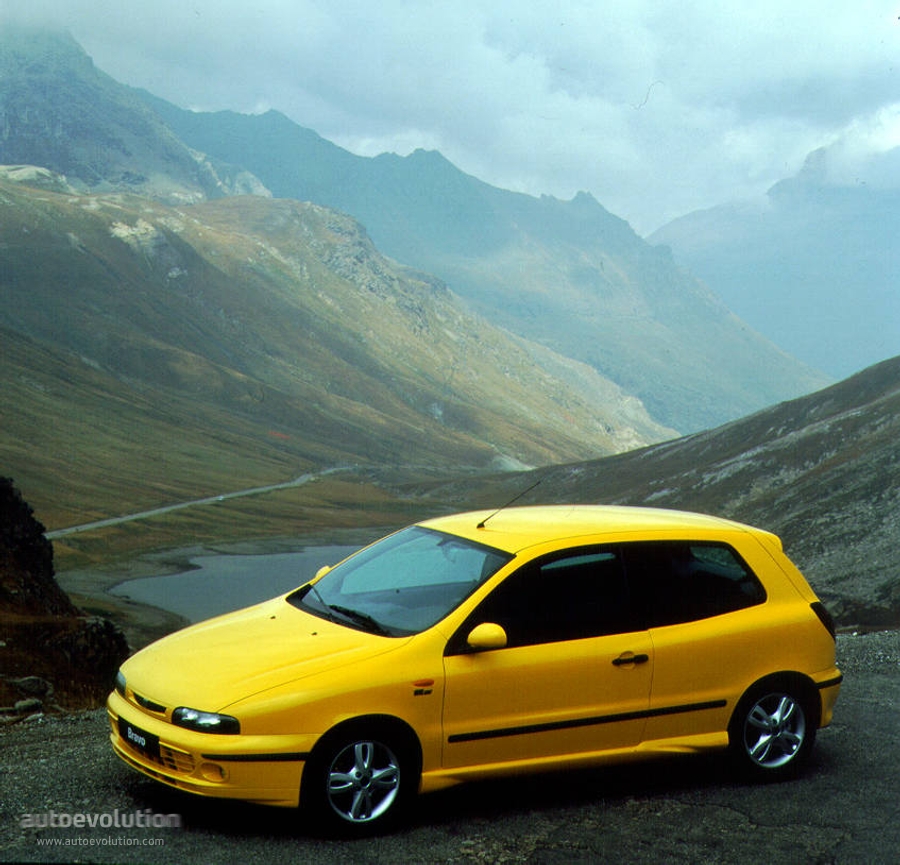| Fiat 147 | |
|---|---|
| Overview | |
| Manufacturer | Fiat |
| Also called | Fiat 147 City (pick-up) Fiat 148 (Panorama, Uruguay) Fiat Brío Fiat Spazio Fiat Tucán Fiat Vivace |
| Production | Brazil: 1976-1987[1] Argentina: 1982-1996 Colombia: 1979-1984 |
| Assembly | Betim,[2]Brazil Córdoba, Argentina Rancagua, Chile Bogotá, Colombia Canelones, Uruguay[3] La Victoria, Aragua, Venezuela[4] |
| Body and chassis | |
| Class | Supermini (B) |
| Body style | 2-door sedan 3-door hatchback 3-door station wagon 2-door coupé utility (pickup)[5] 3-door panel-van |
| Layout | FF layout |
| Related | Fiat 127 Fiat Fiorino Fiat Oggi Fiat Panorama |
| Chronology | |
| Predecessor | Fiat 133 (Argentina) |
| Successor | Fiat Uno |
Share your thoughts, experiences and the tales behind the art. Alfa 147 Tuning 'Turning your 147 into a real track car.' The 147 is a great car and handles really well. Alfa Romeo certainly know a thing or two about producing a sporty car. Despite the great ride and handling in the standard car, there are still plenty of.


The Fiat 147 was a three-door hatchbackcompact car produced by Fiat in the Brazilian state of Minas Gerais from autumn 1976 until 1987, when it was replaced by the FiatUno. It was the Brazilian variant of the Fiat 127. Some were also built by Sevel in Argentina (where later models were named Fiat Spazio, Brío and Vivace[6]) until 1996, and assembly also took place in Colombia, Uruguay, and Venezuela.
Brazil[edit]
During the two decades that followed the Second World War, the available fuels in Europe had featured progressively higher octane ratings, and compression ratios of European cars had increased correspondingly. However, the cheaper (so called yellow grade) petrol widely distributed in Brazil in 1976 had an octane rating of just 73, so for Brazil it was necessary to use a relatively low compression ratio of 7.2 to 1.[2] In order to provide adequate power with the lower compression ratio, a larger engine was needed, and the Fiat 147 was launched with a 1,049 cc (64.0 cu in) unit with a five-bearing crankshaft in place of the 903 cc (55.1 cu in), three-bearing engine that then was still standard in the 127s from Turin.[2] Press reports of the time reported that the larger engine produced a much smoother and quieter drive as well as enhanced torque.[2] The 1,049 cc (64.0 cu in) engine, along with some of the revised bodyshell elements of the 147 (most notably the rear three-quarter panels) were later introduced on the Series 2 version of the 127 itself, when it was released in Europe a year later.
The 147 was the first modern car to use ethanol (E100) as fuel instead of petrol.[7] The performance slightly increased and fuel consumption was 30% higher but the cost of the alcohol was a quarter of that of the gasoline because, at that time, petrol had become expensive as a consequence of the 1973 oil crisis. This version was nicknamed 'cachacinha' (little cachaça) because it had the smell of that drink.
Auto Fiat 147 Tuning Kit
After having been introduced in the fall of 1976, the lineup was divided into 147, 147 L, and 147 GL in November of the next year. A year later yet the luxurious GLS was added, as was the sporty 'Racing' model, fitted with a 63 PS (46 kW) 1.3 liter engine.[8] This engine later found its way into the mildly sporting TR (with 71 PS or 52 kW), as well as (in lower-tuned form) the 147 CLS, Oggi CS, and Panorama CL.[9]
A 45 PS (33 kW) 1,301 cc (79.4 cu in) diesel engine, based on the 1,049 cc unit, was also developed but was only ever marketed abroad, as private car owners in Brazil were not allowed to register diesel cars. This version, complete with face-lifted Brazilian market bodywork, was also exported to Europe as a '127' beginning in 1981.[10] In 1982, the diesel engine was also added to the 'Panorama' station wagon, which also became available in Europe as a 127.[11]
The 147 underwent a number of facelifts during its career. The earliest cars had a front clip similar to the European 127, but later a new, reverse-rake front appearance was developed. Later yet (1983), the front was redesigned to match Fiat's new corporate face as defined by the new Uno. The pre-facelift body remained in use for a few years on the cheapest 147 C – to mark the newer versions as different, they received the additional 'Spazio' label: this name later came to replace the '147' badge in Argentina.[8] Along with the facelift, engine outputs all crept up by a few horsepower. In Venezuela, the Spazio was sold exclusively with the more powerful 72 PS engine as used in the Brazilian TR version.[4] Production of the 147 C continued into 1987, after it had effectively been replaced by the new Uno. A mere 256 cars were built in 1987, however.[12]
Derivatives[edit]
Based on the Fiat 147 was a saloon called the Fiat Oggi and an estate called the Fiat Panorama. The Panorama arrived first, in April 1980, originally with either the 1.05 or the 1.3 L petrol engines. The Oggi first appeared in the spring of 1983, just after the introduction of the second facelift. There were also van and pick-up versions available, sold as the Fiorino. The Panorama was also available with the diesel engine, mainly for European export but also for assembly in Uruguay, where the Panorama was sold as the Fiat 148.[3]
Argentinian career[edit]
Argentinian production of the 147, with the Brazilian 1,049 cc engine, began in summer of 1981. In October 1982, the 1,116 cc four-cylinder unit replaced this engine. In May 1983 a five-speed transmissions arrived for the new, somewhat sporty TR 5. This also received a 60 PS (44 kW) 1.3 liter engine. The 1.3 had already been used for the highly tuned IAVA Sorpasso since 1982, but with a twin carburettor and 90 PS (66 kW).[6] With a top speed of 163 km/h (101 mph), this is the most powerful factory-built 127 derivative ever.[8] 405 Sorpassos were built until 1984.[6] At the opposite end of the spectrum the 147 TRD, fitted with the same diesel engine as Brazilian-built 147s, was added during 1984.
In November 1984 the new Spazio appeared, with the same front clip as the second facelift used in Brazil.[13] Big, square headlights and bumpers, along with re-designed taillights and Fiat's current corporate grille made for a much more modern appearance. Engines and equipment levels remained unchanged, although the smaller 1.1 and the diesel disappeared by 1990. The 1.3 was complemented by a larger 1,372 cc version in 1991, this was renamed the Fiat Vivace in 1993. Production continued until 1996.
An interesting sub-species was the 1987 Fiat Brío - this utilized the original, pre-facelift, Brazilian bodywork from 1976 for a special bargain version with the 1.1 engine. The Brío was discontinued in 1989.[6]
Production and markets[edit]
A total of 1,269,312 units were produced in Fiat's Brazilian factory in Betim, plus 232,807 units in the Sevel plant of Córdoba, Argentina. This car was also assembled in the CCA plant in Bogotá, Colombia.
A few Fiat 147s were exported to Europe, either with the diesel engine or with the Panorama bodywork. Aside from the two different fronts used (first and second facelift), they can also be differentiated from Italian-built Fiat 127s (and the corresponding Spanish-built Seat 127s) by the extractor vents in the rear three-quarter pillar.
References[edit]
- ^'Fiat 147 / Spazio: 1976 – 1987'. Fiat PRESS (in Portuguese). Fiat Automóveis. Retrieved 2013-02-13.
- ^ abcd'Tough Nut: Special version of the Fiat 127 for the Brazilian market'. Autocar. Vol. 145 (nbr 4180). 11 January 1973. p. 51.
- ^ abMastrostefano, Raffaele, ed. (1985). Quattroruote: Tutte le Auto del Mondo 1985 (in Italian). Milano: Editoriale Domus S.p.A. pp. 336–338. ISBN88-7212-012-8.
- ^ abTutte le Auto del Mondo 1985, p. 340
- ^'Grandes brasileiros: Fiat 147 Pick Up' (in Portuguese). Quatro Rodas. Archived from the original on 2013-07-16. Retrieved 2012-07-03.
- ^ abcd'Fiat 147'. Coche Argentino (in Spanish). Retrieved 2012-02-17.
- ^'A bit of history: Fiat 147, the first mass-produced ethanol car'. autobloggreen.com. Retrieved 2009-04-18.
- ^ abcBüschi, Hans-Ulrich, ed. (March 10, 1983). Automobil Revue '83 (in German and French). 78. Berne, Switzerland: Hallwag, AG. p. 294. ISBN3-444-06065-3.
- ^Büschi, Hans-Ulrich, ed. (March 1, 1984). Automobil Revue '84 (in German and French). 79. Berne, Switzerland: Hallwag, AG. ISBN3-444-06070-X.
- ^Ward, Phil (August 15, 2007), Great Small Fiats, Veloce, p. 64, ISBN978-1-84584-133-1, OL8961119M
- ^Ward, p. 65
- ^'Fiat 147 / Spazio: 1976 – 1987: Voluma ano a ano' [Yearly production]. Fiat PRESS (in Portuguese). Fiat Automóveis. Retrieved 2013-02-13.
- ^Büschi, Hans-Ulrich, ed. (March 5, 1987). Automobil Revue 1987 (in German and French). 82. Berne, Switzerland: Hallwag AG. p. 279. ISBN3-444-00458-3.
External links[edit]
- Fiat 147 history(in Portuguese)
Fiat car timeline (South America), 1980s–present | |||||||||||||||||||||||||||||||||||||||||
|---|---|---|---|---|---|---|---|---|---|---|---|---|---|---|---|---|---|---|---|---|---|---|---|---|---|---|---|---|---|---|---|---|---|---|---|---|---|---|---|---|---|
| Type | 1980s | 1990s | 2000s | 2010s | |||||||||||||||||||||||||||||||||||||
| 0 | 1 | 2 | 3 | 4 | 5 | 6 | 7 | 8 | 9 | 0 | 1 | 2 | 3 | 4 | 5 | 6 | 7 | 8 | 9 | 0 | 1 | 2 | 3 | 4 | 5 | 6 | 7 | 8 | 9 | 0 | 1 | 2 | 3 | 4 | 5 | 6 | 7 | 8 | 9 | ||
| Economy car | Hatch | 147 / Spazio | Mille | Mobi | |||||||||||||||||||||||||||||||||||||
| Uno | Palio I | Palio II | Argo | ||||||||||||||||||||||||||||||||||||||
| Uno II | |||||||||||||||||||||||||||||||||||||||||
| Sedan | Oggi | Prêmio/Duna | Siena | Grand Siena | Cronos | ||||||||||||||||||||||||||||||||||||
| Subcompact | Punto | ||||||||||||||||||||||||||||||||||||||||
| Compact | Hatch | Tipo | Brava | Stilo | Bravo | ||||||||||||||||||||||||||||||||||||
| Sedan | Tempra / Tempra SW | Marea / Marea Weekend | Linea | ||||||||||||||||||||||||||||||||||||||
| Coupé | Coupé | ||||||||||||||||||||||||||||||||||||||||
| LCV/LAV | Fiorino I | Fiorino II | Fiorino III | ||||||||||||||||||||||||||||||||||||||
| Doblò | |||||||||||||||||||||||||||||||||||||||||
| Ducato | |||||||||||||||||||||||||||||||||||||||||
| Mini MPV | Idea | ||||||||||||||||||||||||||||||||||||||||
| Pickup | City | Fiorino Pick-up | Strada | ||||||||||||||||||||||||||||||||||||||
| Toro | |||||||||||||||||||||||||||||||||||||||||